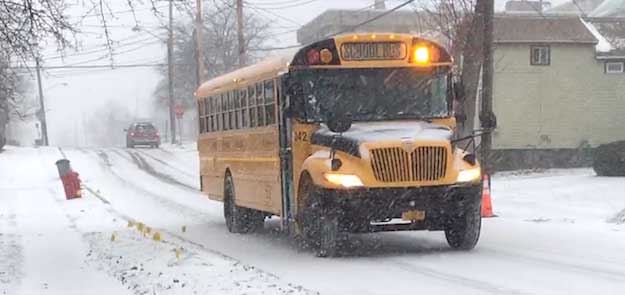School bus driver shortage felt state-wide, according to report
Press Release, NYS School Boards Association
More than eight in 10 school transportation directors in New York consider driver shortage either their “number one” problem/concern (60 percent) or a “major” problem/concern (23 percent), according to a report by the New York State School Boards Association, New York Association for Pupil Transportation and National Association for Pupil Transportation (NAPT).
A shortage of bus drivers can have significant consequences for school districts and the children they educate, including: lengthy bus trips as districts consolidate routes; delayed arrivals and departures; cancelled field trips and extracurricular activities; increased costs as a shortage of drivers drives up wages; and, in extreme cases, children and families having to provide their own means of transportation to and from school.
In some districts, a lack of bus drivers can become a safety issue. Districts with severe shortages often have to press fleet mechanics into bus driver service, meaning bus repair and maintenance may suffer.
“Transporting students to and from school is an often overlooked component of a school district’s responsibilities, but has a significant impact on student learning and safety,” said NYSSBA Executive Director Timothy G. Kremer. “The importance of school bus drivers is most evident when there is a shortage of them.”
The report found that three-quarters (74 percent) of New York’s school transportation directors had unfilled school bus driver positions at some point during the 2017-18 school year. More than one-quarter of school districts (27 percent) had as many as 11 to 20 percent of unfilled school bus driver positions at some point during the school year.
The shortage of school bus drivers in New York appears to be a problem in all regions of the state, although some regions are impacted more greatly than others. In every region of the state north of New York City, at least 72 percent of transportation directors said driver shortage was their number one problem or a major problem.
School bus driver shortages appear to have gotten worse. Asked to characterize the school bus driver shortage trend for their school district or transportation companies over the past three years, seven of 10 survey respondents said the problem was either “significantly worse” (38.5 percent) or “somewhat worse” (32 percent). Nearly one-quarter (23 percent) said the problem was “about the same.” Only 6.5 percent of respondents said the problem had gotten “somewhat better” (5 percent) or “significantly better” (1.5 percent).
The biggest factor contributing to bus driver shortages, according to the report, are recent federal and state requirements that have made obtaining a commercial driver license (CDL) more costly and time-consuming.
The report recommends that school leaders and transportation directors work closely with the state Department of Motor Vehicles to make obtaining a CDL less burdensome without sacrificing safety, including expanding the number of testing sites which must meet federal standards; training and preparing examiners for the new testing regimen to increase consistency among them and their approach to the test; and further adjusting the availability of testing times to include weekend appointments.
It also highlights a number of other actions that can be taken at the local level as well that can improve school bus driver recruitment and retention, such as providing free training, defraying other costs related to obtaining a CDL and/or starting employment, and exploring ways for school transportation and human resources departments to work together in the recruitment, training and retention of bus drivers.










































































